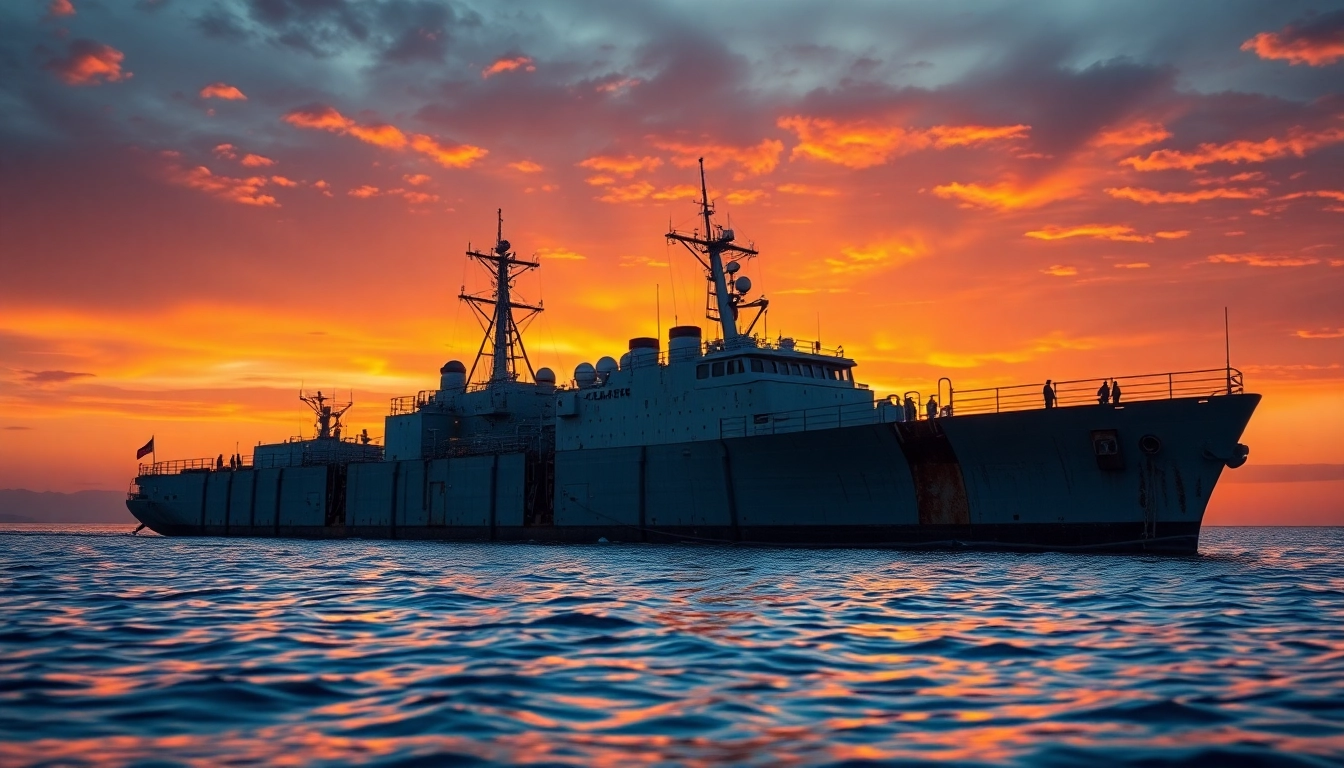Introduction to LSM44: A Historical Overview
The USS LSM-44 represents a fascinating chapter in naval history, embodying the innovations and strategic necessities of World War II and beyond. To understand its significance, one must explore what LSM-44 is, its place within the United States Navy, and the legacy it has left behind. For more information on the LSM-44 and related topics, feel free to delve into the resources available at lsm44.
What is LSM44?
LSM44 refers to a United States Navy Landing Ship Medium (LSM) that was constructed during World War II, specifically to transport troops and equipment to forward combat areas. The design of the LSM class allowed for beach landings, making it essential in the amphibious warfare strategy employed by Allied forces. LSM-44 was launched from the Brown Shipbuilding Company in Houston, Texas, on September 15, 1944, and served a critical role in the Pacific Theater of operations.
Significance in the Navy
The LSM class was crucial to the success of WWII naval operations, facilitating the movement of troops and materials among far-flung islands in the Pacific. LSM-44, like its sister ships, played a vital support role, participating in numerous landings that helped to ensure victory for Allied forces. By being capable of carrying tanks, vehicles, and troops, LSM-44 and her fleet contributed substantially to the operational flexibility of naval forces.
Legacy and Recognition
Despite being decommissioned after the war, the legacy of LSM-44 lives on. Many naval historians regard the LSM class as a key evolution in landing craft design, bridging the gap between earlier designs like the LCI (Landing Craft Infantry) and later developments that would take more significant roles in naval operations. The durability and unique capabilities of the LSMs influenced future naval designs and operational strategies, and LSM-44’s history is preserved in various maritime museums and naval history forums.
The Construction and Design of LSM44
The construction and design of LSM-44 reflect the needs and technological capabilities of its time. This section explores the specifics of its engineering as well as the innovations that it brought to modern shipbuilding.
Engineering Specifications
The USS LSM-44 was designed for functionality and robustness, constructed to withstand the rigors of amphibious operations. The ship measured approximately 203 feet in length and 33 feet in beam, providing ample deck space for operations. Its shallow draft of around 7.5 feet allowed it to navigate through coastal waters, facilitating direct beach landings. Outfitted with two diesel engines, the LSM-44 could reach speeds of around 12 knots, balancing speed and cargo capacity. Its design also included a strong bow ramp, which was essential for rapid vehicle and personnel disembarkation.
Innovations in Design
During its design phase, the LSM-44 incorporated various innovations that enhanced its effectiveness as a landing craft. The vessel implemented a ‘broad-beam’ design, which provided added stability and ease of loading and unloading under any sea conditions. Another significant improvement was its versatility; the LSM was capable of operating in a variety of environments, from beaches to deep waters, making it ideal for multi-coastal operations.
Impact on Landing Ship Standards
LSM-44 and her counterparts set a new standard for landing craft in the U.S. Navy and other naval forces worldwide. The attributes instantiated in their design influenced future classes of landing ships, emphasizing the importance of versatility, cargo capacity, and stability. The lessons learned from the operational experiences of LSM-44 continue to guide modern naval craft design, ensuring that the needs of amphibious operations are met effectively and efficiently.
Operational History of LSM44
The operational history of LSM-44 encompasses various missions and deployments that illustrate its significance during and after World War II. This section details these missions, the challenges encountered, and the broader impact on naval tactics.
Key Missions and Deployments
LSM-44 was involved in critical operations during World War II, primarily in the Pacific. Notably, it participated in various landings that included operations in the Philippines and the key battles of Iwo Jima and Okinawa. Each of these missions required careful planning and execution, and LSM-44 was central to delivering troops and supplies to the front lines. Its ability to operate close to enemy territory made it a crucial asset during these intense combat operations.
Challenges Faced During Service
Operational challenges were prevalent throughout the service history of LSM-44. Navigating the unpredictable waters of the Pacific posed significant threats from typhoons, rough seas, and enemy forces. The crew faced logistical hurdles associated with offloading vehicles and supplies under enemy fire and difficult nighttime conditions. Moreover, as a medium landing ship, LSM-44 had to adapt to evolving enemy resistance, necessitating a strong operational mindset and flexibility from its crew.
Influence on Naval Tactics
LSM-44’s operational history provided insights that deeply influenced modern naval tactics. The performance of LSM-44 in combat demonstrated the efficacy of utilizing landing ships for swift troop movements, emphasizing the necessity of logistical planning in amphibious warfare. The after-action reports and data collected during its missions contributed to future naval strategies, helping ensure that naval forces understood the conditions necessary for successful landings. Such strategies have been implemented in numerous conflicts since WWII, shaping how the Navy approaches amphibious operations today.
Modern-Day Significance of LSM44
The legacy of LSM-44 continues to resonate in contemporary culture and naval history. This section highlights restoration efforts, memorials, and the importance of connecting with veterans to preserve its story.
Restoration Projects and Heritage
In recent years, efforts have emerged to honor and preserve the remnants of LSM-44 and its sister ships. Various naval museums across the United States are undertaking restoration projects aimed at showcasing the historical significance of the LSM class. Such projects provide essential educational resources, helping the next generations appreciate naval history. Community involvement in these efforts often cultivates a deeper connection between history and the local populace, fostering respect for veterans and acknowledgment of their service.
Commemorative Events and Memorials
Numerous commemorative events and memorials have been established to honor LSM-44 and its crew. These events often take place on significant anniversaries related to World War II battles and naval deployments. Veterans and their families come together to share stories, remember sacrifices, and educate attendees about the important role of vessels like LSM-44. Such gatherings not only celebrate history but foster communal bonds, ensuring that those who served are remembered respectfully.
Connecting with Naval Veterans
Connecting with naval veterans through organizations dedicated to preserving naval history is a vital aspect of honoring LSM-44’s legacy. Various digital platforms, forums, and military associations facilitate engagements between veterans and the public. These interactions provide invaluable opportunities for learning, sharing stories, and documenting experiences that might otherwise be lost to time. Efforts to preserve these narratives are crucial in building a comprehensive picture of the sacrifices and challenges faced during the service of ships like LSM-44.
Engaging with LSM44: How to Get Involved
For those interested in engaging with the legacy of LSM-44, various avenues provide opportunities to contribute or simply learn more. This section outlines how individuals can get involved through visitation, participation in events, and contribution to the legacy.
Visiting Historical Sites and Museums
Visiting historical sites and maritime museums dedicated to naval history offers insight into the significance of ships like LSM-44. These venues often house exhibitions, artifacts, and detailed accounts of the operational history of landing ships. Engaging with living history through guided tours or reenactments further enhances this experience, creating a visceral understanding of naval operations during World War II.
Participating in Naval Events
Participation in naval events—such as parades, reenactments, and commemorative gatherings—allows individuals to connect with the naval community profoundly. These events often highlight the achievements of veterans and educate the public about the pivotal roles played by vessels like LSM-44 in maritime warfare.
Becoming a Contributor to LSM44 Legacy
Contributing to the legacy of LSM-44 can take many forms, from writing articles to volunteering at naval museums dedicated to preserving maritime history. With increasing digital documentation, individuals can also leverage platforms to share personal stories from veterans, ensuring their experiences remain etched in historical memory. Such contributions not only enrich our understanding of history but also instill a sense of duty to future generations.















Leave a Reply